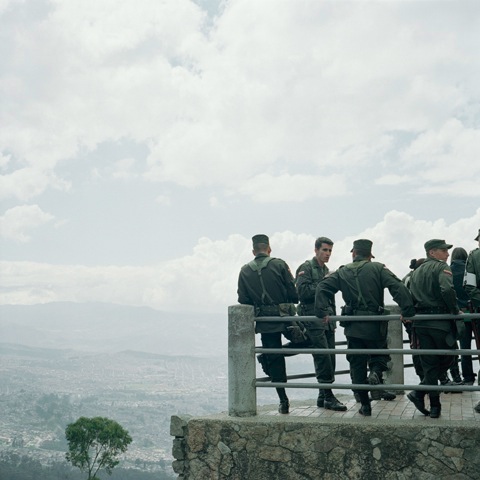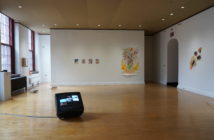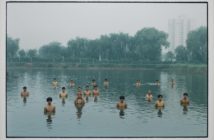Alec Soth's exploration of Bogota stemmed originally from the adoption of his baby girl. The girl's biological mother made a book full of letters, pictures, and perms and gave it to Soth and his wife. Upon receiving the book, Soth spent the next two months, while waiting for the adoption to go through, photographing Bogota to make his own book for his new daughter.
The first thing one notices is the color. The opposite of vibrant, the photographs are filled with muddled blues and faded reds. Soth meant for these images to be a story for his daughter, of where she was born, using the color to symbolize a faded memory. In an image of what looks like soldiers, Soth captures them on an overlook, portrayed as sight seeing. The image relies simply on a palette of gray, from the sky to the fog covering the city, and the green of the uniforms. The image, with the soldiers at partial attention, is still oddly serene, hanging in a picturesque sky.
Another theme found in this work is a little more literal: Dogs. One of his photographs is that of a dog peaking over a fence. Contrary to the idea that dogs have it hard in third world countries, this photograph portrays a different mood; that of aloneness, another of eagerness. In contrast to the repetition of dogs, Soth included only one child in this series. Perhaps, he connected to the children of Bogota because of his adoption and therefore felt uncomfortable taking photographs of them. The dogs, therefore, could be seen as a substitute orphan. The people that Soth photographs, in contrast with the dogs, feel more like portraits, and are sometimes staged as such. The end result is a collection of images seen through the eyes someone trying to understand the place, and yet can never fully grasp how their presence transforms it. Does Dog Days refer to the abundance of dogs in the city, or to the metaphor to the hottest days of the summer (or to the apparent wildness of the city)?
The text that introduces this body of work gives the viewer this pre-formed idea of his work. One can become quickly enthralled with the notion that this set of images is meant to show his daughter Bogota. How different would these images seem to be without that information? Would we immediately look at these images and go, how do they relate to a child? If this is a collection is intended for his daughter, why are they exhibited here? Does the back story allow our looking as an audience? Does his business and new relationship allow him insight, and ultimately the agency, to make art photographs to this place? Perhaps, Soth would like the viewer to think of the context, but after that, for better or for worse - the story is up to you, with all of the titles listed asUntitled.
In 1933, documentary (and art) photographer Walker Evans had traveled to Cuba ostensibly to photograph Carlton Beals' book,The Crime of Cuba. Rather than illustrating Beals' imperialist critique of American influence in Cuba, Evens photographed the street life available to him. Over time, and years after the communist revolution, these images have lost their edge, and have in fact, become relics of a bygone era. These images were also shot before his most well known work shot for the Farm Security Administration in the mid-1930's, and serve as a "warm-up" for the negotiations that entail his brand of street portraiture. Soth follows an analogous path, winning the 2003 Santa Fe Prize for Photography, one year after traveling to Bogota, with a different body of work that would develop into one of his most well known collections of work, Sleeping By the Mississippi. In Evans' time, documentary was seen as transparent, but today, documentary is seen as anything except transparent. Soth accepts the limitations, offering explanations in previous interviews that this set of work all reflects his looking being influenced by his experience. The photographs become less about what is photographed, and more about substitutions, stand-ins, and projections. These all are kinds of filtered experience.
According to Soth, in their adoption experience, new parents are given little or no information about the background of their child. Rather than worrying about the details of such a process, these images can also be seen as busy work: an activity that is a substitute for pacing the floor. Therefore, maybe what we see pictures is Soth's desire to use a vehicle to best allow access to an area that in unknown, or perhaps forbidden, to an outsider. Not forbidden in the sense that one cannot come to see, but that is all an outsider can ever do is look.
- Alec Soth, Untitled 15, Bogota.
- Alex Soth, Untitled 02, Bogota.
- Alex Soth, Untitled 35, Bogota.
"Alec Soth Dog Days Bogota" is on view until November 28th at Stephen D. Paine Gallery, at Massachusetts College of Art and Design, located at 621 Huntington Ave, Boston, MA.
All images are courtesy of the artist and MassArt.







